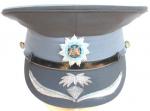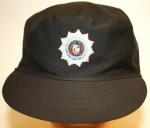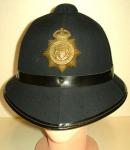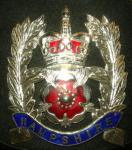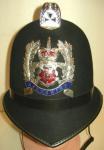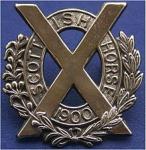-
Posts
13,225 -
Joined
-
Last visited
-
Days Won
22
Content Type
Profiles
Forums
Blogs
Gallery
Events
Store
Everything posted by Mervyn Mitton
-
The British have used a particular style of cavalry sword for many years. The more recent ones have been the 1853 pattern - which had a three bar guard - and from 1864 a bowl style guard with a curved blade. The last type was the 1899, which unlike the earlier ones did not have a Maltese Cross cut into the bowl. The problem with a 'slashing' sword is that the law of physics comes into things - forward momentum of the sword coming down + speed of the horse at a gallop = falling off. During the Boer War this happened many times - the worst occasion being when an entire Troop of 23 men fell off. The Boers must have been very surprised - probably thought it was another 'evil' plan by the Uitlanders ! When the War concluded the British War Office set-up a Royal Commission to look at the problem - and in 1908 their new design was unveiled. Unlike the previous curved swords , this was thin, and pointed - and long. Generally regarded as one of the best balanced swords this was a formidable weapon. Apart from it's fighting abilities it also gave us those popular gymkhana events - tent pegging and collecting the hanging rings. The officers' version was introduced in 1912 and is the same apart from the bowl guard. This one has a Celtic intertwined design - and a better grip. This morning I purchased the sword shown here - I could see the similarities with the 1908 immediately - however, it is obviously not British. There is some wording on the blade and I think I recognise the last word as a Dutch town - it would be nice to have confirmation of this ? I am showing a number of pictures of the sword , together with the 1908 for comparison. The dirt of ages is engrained on the Dutch one - this is prior to a light cleaning.
-

South West African Police Cap Badge Pre-1939
Mervyn Mitton replied to sabrigade's topic in Police Forces of the World
-

South West African Police Cap Badge Pre-1939
Mervyn Mitton replied to sabrigade's topic in Police Forces of the World
-

South West African Police Cap Badge Pre-1939
Mervyn Mitton replied to sabrigade's topic in Police Forces of the World
Will - an almost unique badge - I'm with Chris in never having seen one before. The SAP used helmets pre-war and up to the early 50's. This looks like the smaller pattern from post - war. Here are a couple of SWA Police badges just prior to it becoming Namibia. This is the SAP helmet that I think it must have been worn-on. -
Cathey and Rex - I have admired your swords on the Collections section - however, your display of prints and early weaponry is exceptional. Sincere congratulations - it is a pleasure to see such expertise . However, I must say - what particularly impressed me, was your comment that you needed time to paint a matching Wellington. Your painting of Napoleon would bring a considerable sum - in South Africa alone, we have three Napoleonic Societies. Now, you've rather left yourselves open when you ask which prints we would like enlarged - the obvious answer is -- all of them ! We must be realistic though, and perhaps , for my part, I would like the 'Thin Red Line' and perhaps the two of Lord Nelson - particularly his final embarkation for HMS Victory. I think this post on early prints will continue to grow - we have been fortunate to start off so well. Mervyn
-
I like the new one - but perhaps a little 'plasticky' however, it is very clear and probably better when you can hold it. I still think the original 'special police' had a nice look - typical of the old American styles. Mervyn
-
Interesting that you have specialised in the RNAS - I have a very rare medal to the original unit in WW1. He was an 'ace' for RNAS and is credited with 7 'kills' - he was awarded the DFM - for which only 105 were given before the end of the War. DFC's were much higher. There is a query in the naming and I keep meaning to have an expert researcher draw the papers. With full authentication it will be worth 5000 pounds. Is it only the uniform you have an interest in - I look forward to hearing from you - and, please give us a first name ......... Mervyn ps. Going back to the hat - are you saying that you think it is a made-up job ?
-
Les - you certainly don't ask easy questions ! I regret that I can't give you the exact answer you are looking for - and unless you can find access to early Orders laying down the format - I doubt that you ever will. I hope money wasn't riding on this ? Knowing how the British mind works - and having attended enough Church Parades - I would say that British Officers wouldn't have worried in the least about whether the men understood the service. For them the important thing would be that it had been held in accordance with instructions.
-
Mike - shame you had to take another thread - you will have to contact Nick when he returns. This is the correct cap badge for Scottish Horse. That does not mean that yours wasn't in use - just probably not as a headdress badge. Yours has an appearance of age and the material certainly looks to have been in use for quite a while. From the size - could it perhaps be part of a pair for lapels ? Perhaps someone else will recognise ? Mervyn
-
I must be honest and say that if I didn't know that they used this shape - and the Gieves label - then I could easily take this for a made-up piece. The shape of the cap is - to me - very Germanic. However, I see the owner's name is on the label - that will be your best place to start. Write to the Airforce Museum. Not sure if there is a RNAS Museum - perhaps at Yeovilton ?
-
I went into some opinions on the Riots in Britain, on the Lounge this morning. However, I thought with our Police membership and friends on this Forum, that I would give you a little background on what happened in Tottenham on Saturday night. Perhaps it will lead to a discussion on how other Countries deal with outbreaks of viloence. Firstly, as I said on the Lounge - rioting is quite common in the Britain - perhaps not as bad as in France, but enough that it had it's own Riot Act to cover eventualities. Once read by a Magistrate the Police were given much greater powers to deal with the unrest. Unfortunately, some years ago the Act was repealed and substituted with the Public Order Act. This has it's moments and has strong penalties - the problem is that a liberal style of Government inhibits judges from proper sentencing. One of the reasons it was repealed was that once the Police styled it a Riot - they became responsible for paying all damage out of the Police Budget....... Those who have my book will see that I listed some of the earlier riots - however, they have become fairly common over the last 45 years. I took part in the major ones at the US Embassy in Grosvenor Square - at Rhodesia House in the Strand - at the Sth. African Embassy and also, at the Turkish Embassy when they seized half of Cyprus. Not something to look back at with any pleasure - to use an old British phrase - 'Bloody frightening !" Now , to come back to Tottenham. This is an inner North London suburb - run down, and where I would not like to have been a Police Officer. During the 1960's ,the Government of the time built massive concrete developments - one of these was the Broadwater Farm Estate. Covering acres it was a mass of tall blocks of flats - lower terrace houses and hundreds of small alleys - the main entry way was across a bridge. Over a few years people moved away - it was such a dangerous place to live. West Indian migrants moved-in and tried to make it their own territory and to keep the Police out. They were quite succesful but, despite the hostility young Home Beat Constables were appointed to try and keep a Police presence. One of these was a young family man - Constable Keith Blakelock. The young savages controlling the building set a trap for him and when he was attempting to answer a call they attacked him. He was tortured - cut to pieces - and beheaded. This last was always kept from the public. However, I think it is time it came out. My book had just been published and I was badly shaken by the whole incident - although I was not in the Police at that time. Via the Ch. Supt. in charge of the case I sent his son a copy of the book - with a note saying this was his Father's heritage to him. For some reason it was not given to him or, his Mother. Some years ago when the Supt. died the Solicitor (Lawyer) contacted me and asked should he try to track Constable Blakelocks son. I said yes - and eventually, I had a lovely letter of thanks from him - and at that time he was a constable with Devon and Cornwall. That is the background to this area - when armed Police attempted to arrest an armed suspect on Saturday the whole area was called out to protect their territory. One of the blocks they set on fire had 32 flats totally destroyed. The additional villain in this recent - and ongoing - saga , has undoubtedly been the social networks - Twitter etc. Having given this background I hope we can have a discussion from the Police point of view. How to deal with riots like this ? How to control Twitter ? How to give better protection to our Officers' and of course to the public ? I will say that I am surprised that homeowners' did not band together to defend their homes and cars - our Police have always been a civilian one - and that includes support from the public they protect. I look forward to your comments - and how you think these events would be dealt with in your Countries ?
-

My New Kris..! :) (*** MODERATORS' CHOICE)
Mervyn Mitton replied to kapten_windu's topic in Swords & Edged Weapons
We had a long post on these beautiful objects some time ago - but, it is a subject that should come-up regularly. Particularly when the old ones are re-shown. Some interesting facts have emerged - however, I am not sure arsenic should be used regularly - perhaps only when it is being made ? Apart from that it is illegal to have arsenic - it is a schedule 1 poison. Looking at Hugh's last one, I would have thought a little rub down with a light gun oil would help to preserve the patina. I was particularly interested in Windu's comment that carrying a blade was essential for a 'gentleman' to show his status. This was exactly the case in England (I say that in the singular - we predated most of the other Countries within Britain - but, probably not Scotland). Only a Gentleman - or, his family could carry a sword - let the peasantry be caugh with one and it was a death sentence ! With-in England an Esquire was the lowest rank to have the priviledge. -

New Great Britain ribbon bars
Mervyn Mitton replied to Noor's topic in Great Britain: Orders, Gallantry, Campaign Medals
Timo - if only they could talk........... -

My New Kris..! :) (*** MODERATORS' CHOICE)
Mervyn Mitton replied to kapten_windu's topic in Swords & Edged Weapons
Windu - a nice addition to your collection and well decorated. May be new now - but looked after it will become a valuable item. -
Thanks for the extra identification Spaz. I have boxes of R1's as you show - they are not very collectable - however, I had known they they were interchangeable. You have explained it much better ! I had wondered about the overstamping. Mervyn
-
Even more interesting ! I remember that they brought Ch. Constables in during the Victorian period - but, I was not aware that they were District Commanders at this time. One day - someone should trace back all of the different ranks that have been in use and the periods. You mention DAC rank - this had gone into abeyance and if I remember was brought back in the 1970's - one of my friends was an asst. to the DAC for the East London area. I still think we should check that there is a copy in the Met. museum - they've been moved about so much in the past 30 years. When I was at Hendon we were taken to Bow St. to view the Museum and our history - I wonder if they have started these trips again for new recruits ? Odin - I am going to print these photos out to go with the commemorative certificate - adds a lot of interest. Mervyn
-



